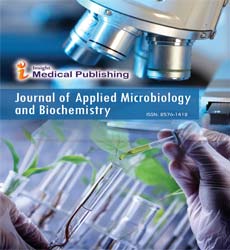ISSN : ISSN: 2576-1412
Journal of Applied Microbiology and Biochemistry
Genetic Innovations to Enhance Stability and Combat Bacterial Resistance
Megan Hayes*
Department of Microbiology, University of Lausanne, Lausanne, Switzerland
- *Corresponding Author:
- Megan Hayes
Department of Microbiology, University of Lausanne, Lausanne,
Switzerland,
E-mail: meganhayes1@gmail.com
Received date: September 19, 2024, Manuscript No. IPJAMB-24-19865; Editor assigned date: September 23, 2024, PreQC No. IPJAMB-24-19865 (PQ); Reviewed date: October 07, 2024, QC No. IPJAMB-24-19865; Revised date: October 14, 2024, Manuscript No. IPJAMB-24-19865 (R); Published date: October 21, 2024, DOI: 10.36648/2576-1412.8.5.243
Citation: Hayes M (2024) Genetic Innovations to Enhance Stability and Combat Bacterial Resistance. J Appl Microbiol Biochem Vol. 8 No.5:243.
Description
The rise of antibiotic resistance poses a serious global health threat, prompting researchers to analyze alternative therapies, with bacteriophages (phages) emerging as one of the most assuring options. These viruses naturally infect and kill specific bacteria, making them highly targeted tools for bacterial infection treatment. However, there are limitations to natural bacteriophages, such as restricted host range, potential for bacterial resistance and limited stability. To overcome these challenges, scientists have begun engineering bacteriophages to enhance their therapeutic efficacy, ensuring they are more effective, reliable and suitable for clinical use.
Engineered host versatility
One of the primary limitations of naturally occurring bacteriophages is their narrow host range many phages only infect specific bacterial strains, limiting their applicability. To make phage therapy more broadly effective, researchers have turned to genetic engineering to expand phage host range. By modifying the tail fibers or receptor-binding proteins on phages, scientists can equip them to recognize and bind to multiple bacterial strains. For instance, in some studies, engineering tail fibers from different phages has enabled single modified phages to target and kill a broader spectrum of bacterial pathogens. Another approach to expanding host range involves phage hybridization. In this process, researchers create a hybrid bacteriophage by combining genetic material from two or more phages, enabling them to infect multiple bacterial strains. This method has shown potential in treating polymicrobial infections, which involve more than one bacterial species. Hybrid phages can be particularly useful for treating complex infections, such as those in wounds or chronic biofilm-related conditions, where diverse bacterial communities are present. Stability is a critical factor for phages intended for therapeutic use. In many cases, phages are administered through the gastrointestinal tract or directly into infection sites where conditions-such as acidic environments or high temperatures-can degrade them. Additionally, phages often need to survive within the human body long enough to locate and infect the target bacteria, making stability enhancements essential for effective treatment. To improve phage resilience, researchers have focused on modifying the capsid proteins that form the phage’s outer structure, enhancing their durability in extreme environments. Through protein engineering, scientists have developed phages that are less sensitive to temperature, pH and other environmental stressors. This has proven especially beneficial for phages used to treat gastrointestinal infections, as these engineered phages can survive the stomach’s acidic environment and reach the intestines, where the target bacteria reside. In addition to structural modifications, scientists have used encapsulation techniques to protect phages during delivery. Encapsulation involves enclosing phages in materials like polymers or liposomes that safeguard them from harsh conditions, prolonging their activity. This approach has been particularly valuable in cases where phages must be stored for extended periods or administered in environments that would otherwise be unfavorable for their stability.
Phage resistance: New solutions
Just as bacteria can develop resistance to antibiotics, they can also evolve to resist bacteriophages, posing a challenge for sustained phage therapy. However, genetic engineering offers several strategies to address this issue and minimize the potential for bacterial resistance. One assuring approach is to engineer lytic enzymes-proteins that break down bacterial cell walls-to make them more effective. By incorporating these engineered enzymes into phages, researchers enhance the bactericidal activity of phages, making it more challenging for bacteria to develop resistance. Scientists have also begun incorporating CRISPR-Cas systems into phages as a tool to target bacterial DNA. CRISPR (Clustered Regularly Interspaced Short Palindromic Repeats) can be programmed to target specific genetic sequences, allowing phages to disrupt essential bacterial genes directly. This approach effectively "reprograms" bacteria, reducing their ability to survive or replicate and enhancing the therapeutic efficacy of phages. Moreover, CRISPR-equipped phages are less likely to trigger bacterial resistance because they can continuously adapt to bacterial defense mechanisms by targeting new sequences. Additionally, researchers have analyzed phage cocktails, which combine multiple phages to target different parts of bacterial cell walls or DNA. This approach not only makes it more difficult for bacteria to develop resistance but also allows phage therapy to address mixed infections involving diverse bacterial populations. Phage cocktails have shown success in clinical settings, particularly against multi-drug-resistant bacterial strains, where traditional antibiotics have failed. Engineering bacteriophages to improve therapeutic efficacy is a assuring advancement in combating antibiotic-resistant infections. By extending phage host range, improving stability and addressing bacterial resistance, scientists are developing next-generation therapies with greater clinical reliability and adaptability. As genetic engineering technologies evolve, bacteriophage therapy will become more precise and potent, offering personalized treatments against bacterial infections.
Open Access Journals
- Aquaculture & Veterinary Science
- Chemistry & Chemical Sciences
- Clinical Sciences
- Engineering
- General Science
- Genetics & Molecular Biology
- Health Care & Nursing
- Immunology & Microbiology
- Materials Science
- Mathematics & Physics
- Medical Sciences
- Neurology & Psychiatry
- Oncology & Cancer Science
- Pharmaceutical Sciences
